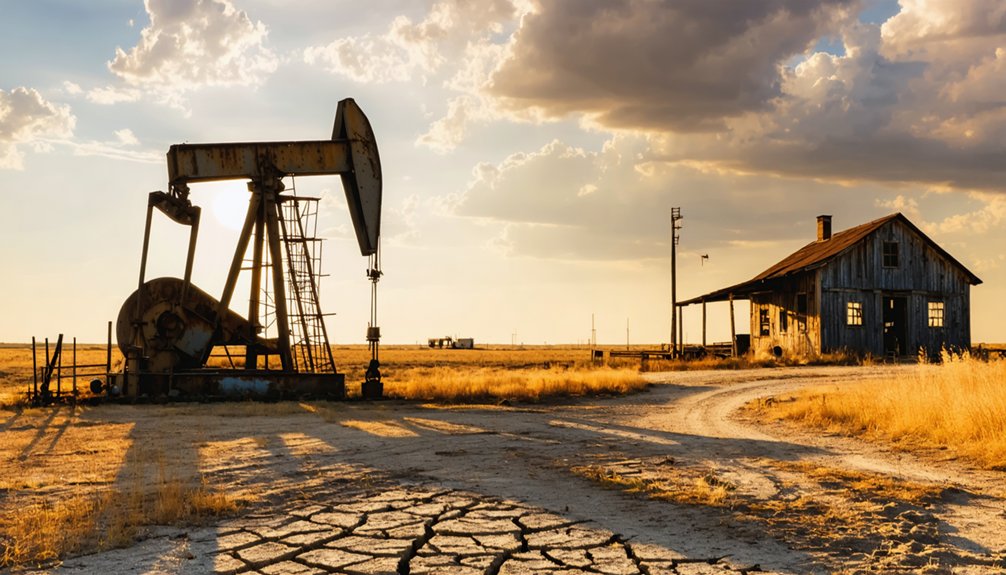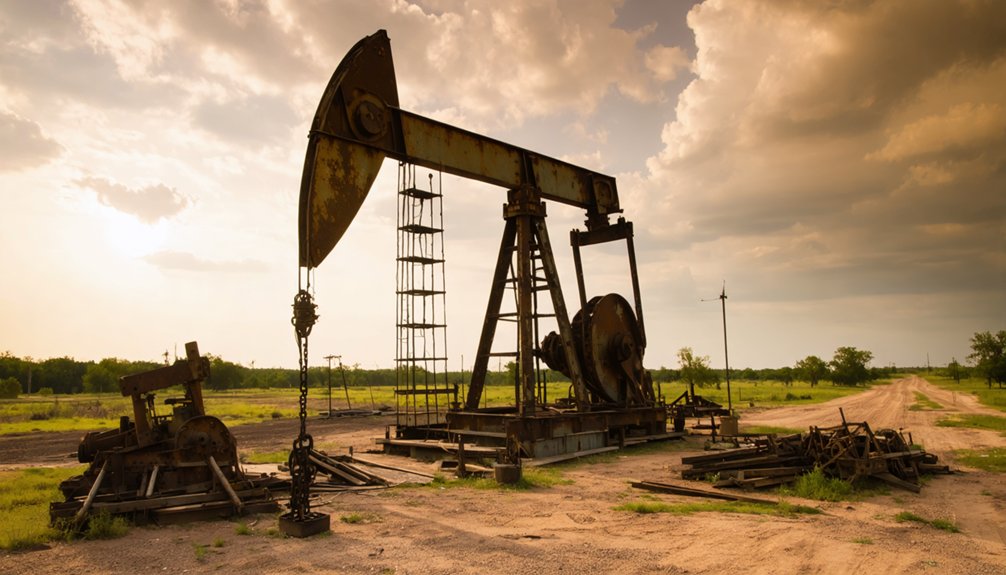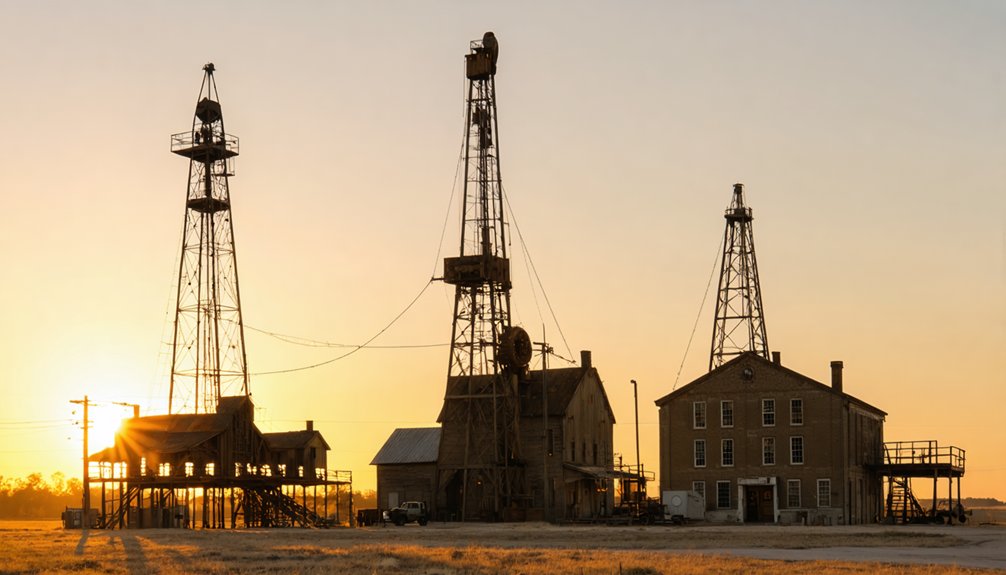You’ll find abandoned oil fields throughout America, particularly in Texas (511 ghost towns), California, and Pennsylvania. These sites feature decaying pumpjacks, derricks, and infrastructure from boom towns that collapsed during market shifts. When visiting, be cautious of environmental hazards like methane leaks and groundwater contamination. Many former boom sites now serve as heritage tourism destinations with museums and guided tours. The following exploration reveals how these industrial relics tell America’s petroleum history.
Key Takeaways
- Abandoned oil fields exist throughout Texas, Pennsylvania, Oklahoma and California, containing thousands of orphaned wells and industrial relics.
- Ghost towns like Oil City and Pithole formed after rapid oil boom-bust cycles dating back to Drake’s first well in 1859.
- Most abandoned sites feature decaying pumpjacks, derricks, and storage tanks creating haunting industrial landscapes for visitors.
- Former oil communities have been transformed into heritage tourism sites with guided tours, museums, and annual festivals.
- Environmental hazards include methane emissions, groundwater contamination, and toxic chemical leaching from nearly 9,000 orphaned wells.
The Rise and Fall of America’s Oil Boom Towns

When Edwin Drake completed the first commercially successful oil well in Titusville, Pennsylvania on August 27, 1859, he unwittingly ignited the nation’s first major oil boom, transforming the American industrial and economic landscape.
The Appalachian Basin quickly became America’s leading production region, spawning settlements like Oil City and Pithole virtually overnight. Before Drake’s discovery, Oil City had fewer than six families residing in the area.
This pattern of explosive growth followed each significant oil discovery. When Spindletop gushed in 1901, production shifted to the Gulf Coast. Oklahoma’s oil industry emerged from humble beginnings with natural oil seeps that were used medicinally by early inhabitants before commercial drilling began.
Boomtown culture emerged as populations surged—Seminole County fields attracted 25,000 people while land prices skyrocketed from $50 to $1,000 per acre.
The black gold rush transformed sleepy rural areas into instant cities as thousands chased petroleum dreams.
However, these towns often vanished as quickly as they appeared when wells dried up or companies relocated, leaving ghost towns scattered across America’s petroleum landscape.
Texas to California: Mapping Ghost Towns Across the Oil Belt
From the sprawling oil fields of Texas to the mineral-rich landscapes of California, America’s abandoned oil towns form a distinctive geographic pattern that tells the story of boom-and-bust economics across the nation’s energy corridor.
Texas dominates the oil town history landscape with 511 documented ghost towns, while California ranks second. When exploring these relics, you’ll notice Texas’s prominence emerged after the 1901 Spindletop discovery, creating company towns like Thurber.
Meanwhile, California’s ghost towns developed during 1880s rail expansion, with settlements like Randsburg reaching 3,500 residents. These locations now serve as educational sites that highlight the historical significance of America’s industrial development.
For ghost town exploration enthusiasts, the geographical distribution extends beyond these states into the Great Plains, where agricultural communities succumbed to the Dust Bowl and economic collapse of the 1930s. Forgotten communities like Provident City were mostly abandoned during the Great Depression, leaving only remnants of once-thriving settlements.
These abandoned settlements—from Belle Plain to St. Mary’s of Aransas—chronicle America’s industrial evolution through their silent structures.
Relics of the Past: Physical Remnants in Abandoned Oil Communities

The physical evidence of America’s oil boom eras persists across the landscape long after populations have departed. As you explore these abandoned sites, you’ll encounter decaying pumpjacks and wellhead equipment—industrial sentinels marking extraction points where fortunes were made.
Despite limited pumpjack preservation efforts, most infrastructure corrodes in place, creating haunting industrial tableaus. These abandoned wells often release poisonous gases that create health hazards for people who venture too close to the sites.
Left to the mercy of time and elements, these mechanical ghosts rust into sculptural memorials of America’s petroleum past.
- Rusting pumpjacks stand frozen mid-stroke, their mechanical arms permanently stilled
- Derrick restoration projects remain rare, with most wooden or metal structures collapsing into recognizable ruins
- Underground pipelines reveal themselves through exposed sections or disturbed vegetation patterns
- Storage tanks collapse slowly, creating circular depressions in the landscape
- Oil-sandstone deposits form black scars, physical reminders of extraction’s environmental cost
Texas alone contains nearly 8,900 orphaned wells that pose significant environmental threats including contaminated groundwater, toxic emissions, and potential blowouts when left unaddressed.
These relics tell a story of boom-bust cycles that transformed communities and then abandoned them to time.
Boom-to-Bust: How Modern Oil Towns Became Ghost Towns
You’ll find the collapse of modern oil towns astonishingly abrupt, with entire communities shifting from prosperity to abandonment within months following dramatic market shifts or resource depletion.
Housing developments that once commanded premium prices during boom periods now stand vacant, with abandonment rates reaching 50-90% in the hardest-hit communities.
These ghost developments represent billions in stranded investment, as infrastructure built to support populations of thousands now serves only a fraction of the intended residents, creating an unsustainable economic burden for remaining local governments.
This stark contrast is particularly evident when comparing to former boomtowns like Midland and Odessa that once led U.S. economic growth with rates exceeding 9% during peak oil production years.
The decline starkly differs from the thriving production in Permian Basin counties where technological advancements have revitalized oil output and sustained local economies.
Overnight Economic Collapse
While oil booms created explosive economic growth in small American towns, their subsequent busts triggered catastrophic economic collapses that transformed thriving communities into modern ghost towns within remarkably short timeframes.
You’ll witness severe economic instability as unemployment skyrockets from 2% to over 13%, devastating local businesses and services.
- Unemployment rates surge dramatically, forcing families into immediate financial crisis
- Food bank usage doubles or triples within months as household incomes plummet by $8,000+ annually
- Businesses serving oil workers close rapidly, eliminating secondary employment opportunities
- High rents persist despite population decline, creating housing insecurity amid economic contraction
- Worker demographic shifts occur as prime-age adults depart while older workers delay retirement
Community resilience is severely tested when oil-sector jobs disappear and replacement work offers substantially lower wages, often leaving behind underutilized infrastructure built for populations that no longer exist. Cities like Pecos suffer from wasteful spending when massive investments in new infrastructure projects suddenly serve drastically reduced populations. Former oil workers who once earned over $100,000 annually now struggle to find employment paying even half those wages.
Ghost Housing Developments
Across America’s oil fields, thousands of hastily constructed housing developments now stand eerily empty, transforming once-bustling oil towns into modern ghost towns within remarkably short timeframes.
You’ll find former worker camps and trailer parks abandoned after the Eagle Ford region’s active rig count plummeted from 221 to just 45.
The bust created a housing affordability crisis as rental prices remained artificially high—$1,200-$1,500 monthly instead of reverting to pre-boom rates of $500-$700.
This pricing disconnect forced many residents into homelessness while properties sat vacant.
Community resilience suffered as economic diversity vanished, leaving populations vulnerable to market volatility.
Former $80,000/year oil workers now struggle in poultry processing jobs while food bank demand has tripled in towns like Gonzales.
These ghost developments represent a stark warning about the dangers of building economies on extractive industry booms.
Environmental Challenges of Abandoned Wells and Equipment

The environmental challenges posed by abandoned oil and gas wells extend far beyond mere industrial eyesores, creating complex ecological threats that affect millions of Americans.
When you explore these ghost towns, you’re witnessing the aftermath of industrial negligence where well contamination threatens groundwater supplies used by over 4.6 million people. Methane emissions from these sites contribute 7-20 million metric tons of CO2 equivalent annually, while ecosystem degradation continues largely unmeasured despite widespread damage.
- Only 8% of documented orphaned wells have nearby groundwater quality data
- The most problematic 10% of wells produce the bulk of methane emissions
- Remediation costs exceed $75,000 per well, with total needs surpassing federal funding by 30-80%
- Toxic chemicals including arsenic and benzene leach into surrounding environments
- Property development drops by 50% in areas with high orphan well concentration
Finding Beauty in Decay: Oil Ghost Towns as Heritage Tourism Sites
Amid the industrial ruins and weathered infrastructure of abandoned oil fields, a surprising transformation has emerged as heritage tourism redefines America’s oil ghost towns.
You’ll find decay aesthetics prominently featured in locations like Spindletop, Texas and Oil City, Pennsylvania, where preserved derricks and pumpjacks serve as monuments to boom-era prosperity.
These once-forgotten communities now attract visitors seeking industrial nostalgia through guided tours, museums, and interpretive displays that chronicle the rise and fall of oil economies.
Visitors flock to these industrial relics, consuming oil town nostalgia through curated experiences of America’s petroleum past.
States with high concentrations of these sites—particularly Texas and California—have converted abandonment into economic opportunity.
Annual heritage festivals and photography opportunities draw crowds, while tourism revenue funds preservation efforts.
Historic district designations provide legal protection, ensuring these rusting remnants of America’s industrial past remain accessible for exploration.
Frequently Asked Questions
Is It Legal to Collect Artifacts From Abandoned Oil Ghost Towns?
You can’t legally collect artifacts without written landowner permission. On public lands, you’ll face serious legal ramifications including felony charges. Consider artifact preservation ethics and contact your State Historic Preservation Office first.
What Safety Precautions Should Visitors Take When Exploring Abandoned Oil Fields?
Wear safety gear including closed-toe boots, gloves, and respirators. You’ll need to avoid physical, chemical, and environmental hazards like unstable structures, toxic leaks, and concealed pipes beneath vegetation.
Are There Guided Tours Available for Major Oil Ghost Towns?
While you seek freedom in abandoned places, you’ll find structure in tourism’s reach. Yes, Jerome, Amboy, and Alanreed offer guided exploration opportunities with varying degrees of formality, impacting local preservation through controlled tourism impact.
How Do Local Communities Feel About Tourism to These Abandoned Areas?
You’ll find community opinions sharply divided. Many locals appreciate tourism’s economic impact, while others worry about commercialization of their heritage, infrastructure strain, and potential damage to historically significant structures.
Can Abandoned Oil Equipment and Structures Be Purchased by Collectors?
Amid a mountain of regulations, you can purchase abandoned oil equipment if you navigate complex legal requirements. Collector interest must align with environmental compliance, property rights verification, and proper decommissioning procedures to secure ownership.
References
- https://www.planetizen.com/node/81347/ghost-towns-remain-after-rush-build-north-dakota-oil-boom
- https://www.youtube.com/watch?v=rwxsDJz3n9g
- https://www.geotab.com/ghost-towns/
- https://grist.org/abandoned-oil-gas-wells-permian-texas-new-mexico/
- https://www.youtube.com/watch?v=oW66pgyhMYM
- https://nondoc.com/2022/01/04/whizbang-oklahoma-ghost-town/
- https://savingplaces.org/guides/ghost-towns-on-route-66
- https://www.texasescapes.com/TexasGhostTowns/Best-Texas.htm
- https://www.okhistory.org/publications/enc/entry?entry=PE023
- https://www.oilcity.org/history



